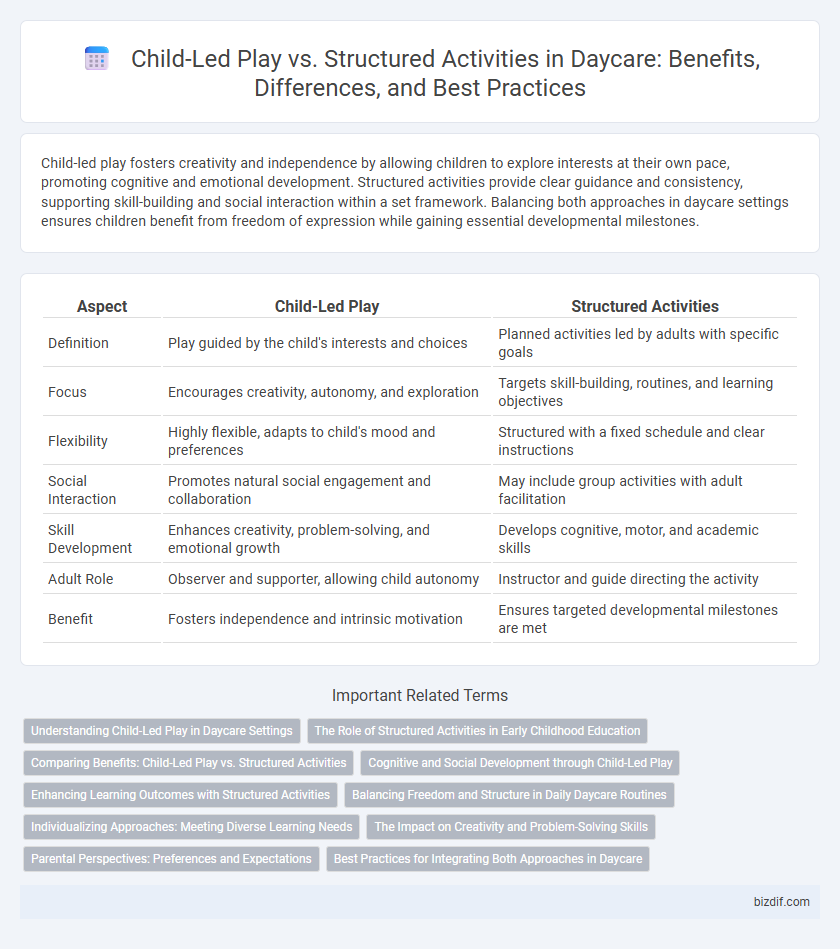Child-led play fosters creativity and independence by allowing children to explore interests at their own pace, promoting cognitive and emotional development. Structured activities provide clear guidance and consistency, supporting skill-building and social interaction within a set framework. Balancing both approaches in daycare settings ensures children benefit from freedom of expression while gaining essential developmental milestones.
Table of Comparison
| Aspect | Child-Led Play | Structured Activities |
|---|---|---|
| Definition | Play guided by the child's interests and choices | Planned activities led by adults with specific goals |
| Focus | Encourages creativity, autonomy, and exploration | Targets skill-building, routines, and learning objectives |
| Flexibility | Highly flexible, adapts to child's mood and preferences | Structured with a fixed schedule and clear instructions |
| Social Interaction | Promotes natural social engagement and collaboration | May include group activities with adult facilitation |
| Skill Development | Enhances creativity, problem-solving, and emotional growth | Develops cognitive, motor, and academic skills |
| Adult Role | Observer and supporter, allowing child autonomy | Instructor and guide directing the activity |
| Benefit | Fosters independence and intrinsic motivation | Ensures targeted developmental milestones are met |
Understanding Child-Led Play in Daycare Settings
Child-led play in daycare settings encourages children to explore their interests and develop creativity, autonomy, and problem-solving skills by choosing activities themselves. This approach supports emotional regulation and social interaction, fostering a sense of independence and confidence in young learners. Research shows that child-led play enhances cognitive development more effectively than strictly structured activities, making it essential for holistic early childhood education.
The Role of Structured Activities in Early Childhood Education
Structured activities in early childhood education provide essential frameworks that support cognitive and social development by fostering problem-solving skills and cooperation. These activities offer consistent routines that help children feel secure, enhancing their ability to focus and absorb new information effectively. Research indicates that well-designed structured tasks complement child-led play by introducing targeted learning goals crucial for foundational skill-building.
Comparing Benefits: Child-Led Play vs. Structured Activities
Child-led play fosters creativity, problem-solving, and social skills by allowing children to explore interests at their own pace, which promotes autonomy and intrinsic motivation. Structured activities provide essential routines and targeted skill development, such as literacy and numeracy, through guided instruction and clear objectives. Balancing both approaches in daycare enhances overall cognitive and emotional growth by combining free expression with focused learning opportunities.
Cognitive and Social Development through Child-Led Play
Child-led play enhances cognitive development by encouraging creativity, problem-solving, and decision-making, allowing children to explore their interests at their own pace. Social skills improve as children engage in cooperative interactions and negotiate roles and rules naturally during free play. Structured activities often provide guidance but may limit spontaneous social learning and critical thinking opportunities found in child-led environments.
Enhancing Learning Outcomes with Structured Activities
Structured activities in daycare settings provide a clear framework that supports cognitive development and skill acquisition by targeting specific learning objectives. These activities use intentional guidance and repetition to enhance problem-solving, language, and social skills more effectively than unstructured play alone. Incorporating diverse structured tasks such as puzzles, group storytelling, and hands-on experiments significantly improves measurable learning outcomes in early childhood education.
Balancing Freedom and Structure in Daily Daycare Routines
Balancing freedom and structure in daily daycare routines enhances child development by incorporating both child-led play and structured activities. Child-led play encourages creativity, decision-making, and social skills, while structured activities promote cognitive growth, routine familiarity, and goal achievement. Creating a dynamic balance supports emotional well-being and maximizes learning outcomes for children in early childhood education settings.
Individualizing Approaches: Meeting Diverse Learning Needs
Child-led play fosters creativity and autonomy by allowing children to explore interests at their own pace, whereas structured activities provide targeted skill development through guided instruction. Individualizing approaches in daycare balance these methods to meet diverse learning needs, ensuring each child receives personalized support that aligns with their developmental stage and learning style. This hybrid strategy enhances engagement, promotes social-emotional growth, and supports cognitive progress in early childhood education.
The Impact on Creativity and Problem-Solving Skills
Child-led play fosters creativity and problem-solving skills by allowing children to explore their interests and experiment with ideas independently, promoting cognitive flexibility. Structured activities provide guidance and introduce specific challenges that develop focused problem-solving abilities and reinforce creative techniques. Balancing both methods in daycare settings enhances children's ability to think divergently and apply logical reasoning in diverse situations.
Parental Perspectives: Preferences and Expectations
Parents often express a preference for child-led play in daycare settings, valuing its role in fostering creativity and independence. Many expect structured activities to support academic readiness and skill development, seeking a balanced approach that meets developmental milestones. Parental perspectives emphasize the importance of flexible programs that adapt to individual child needs while ensuring educational outcomes.
Best Practices for Integrating Both Approaches in Daycare
Balancing child-led play with structured activities enhances cognitive and social development in daycare settings by fostering creativity while providing necessary guidance. Best practices include offering flexible schedules that allow children to switch between free play and guided tasks, ensuring staff are trained to observe and scaffold learning without taking control. Integrating both approaches promotes autonomy, collaboration, and tailored learning experiences that support diverse developmental needs.
Child-led play vs Structured activities Infographic

 bizdif.com
bizdif.com